Table of Contents
Delivery plays a crucial role in shaping customer satisfaction, often serving as the final touchpoint between providers and consumers. For years, furniture businesses relied on manual methods like hand-written logs and spreadsheets to manage the complexities of delivery. These traditional approaches, while functional, often led to delays and errors that could disrupt the customer experience. However, furniture delivery scheduling software has revolutionized the industry, offering a streamlined, efficient solution for handling logistics.
With this software, furniture businesses can now benefit from real-time tracking, automated dispatch, and enhanced communication channels, all contributing to a smoother delivery process. Customers receive their furniture more reliably and promptly, while businesses can better coordinate their resources, reducing errors and improving overall service. This digital shift not only boosts operational efficiency but also strengthens the relationship between consumers and brands, ensuring that delivery meets the high expectations of today’s market.
An Exploration of Furniture Delivery Scheduling Software
Furniture delivery scheduling software has emerged as a pivotal component in the orchestration of modern logistics. Central to the system is a dynamic platform designed to coordinate transportation workflows, ensuring timely deliveries of furnishings to customers. Unlike traditional methods that rely on manual coordination, this intelligent software automates the process, aligning appointments with optimal delivery routes.
Integration with the furniture retail ecosystem is seamless. Store inventory systems, customer relationship management platforms, and supplier databases interlock with the scheduling software to form a cohesive unit. This integrated approach guarantees that the status of each piece of furniture, from the warehouse to the customer’s doorstep, is meticulously tracked and managed.
Software solutions within the industry have undergone a significant transformation spurred by technological advances and changing consumer expectations. This evolution has resulted in a robust suite of scheduling tools with sophisticated algorithms capable of negotiating complex logistics challenges. The software caters to the basic needs of booking delivery slots and considers real-time traffic data, driver availability, and the specific handling requirements of delicate furniture items.
Top Furniture Delivery Scheduling Software
Here’s a top furniture delivery scheduling software, including its pros and cons:
NetworkON
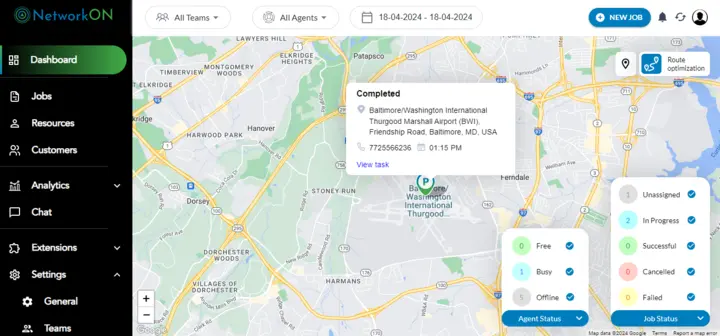
NetworkON is a logistics management platform specializing in last-mile delivery solutions. It helps businesses streamline their delivery processes, manage schedules, and track shipments in real-time.
Pros:
- Integration Capabilities: Seamlessly integrates with existing systems, enabling users to enhance their operations without overhauling their infrastructure.
- Real-time Tracking: This service offers live tracking of deliveries, allowing businesses and customers to monitor the status and location of shipments.
- User-Friendly Interface: Intuitive design ensures ease of use for operators and customers, minimizing the learning curve.
Cons:
- Pricing Structure: Some users may find the pricing to be on the higher side, especially for small businesses with limited budgets.
- Limited Customization Options: While it offers robust features, the customization options may not fully meet every business’s unique needs.
Track-POD
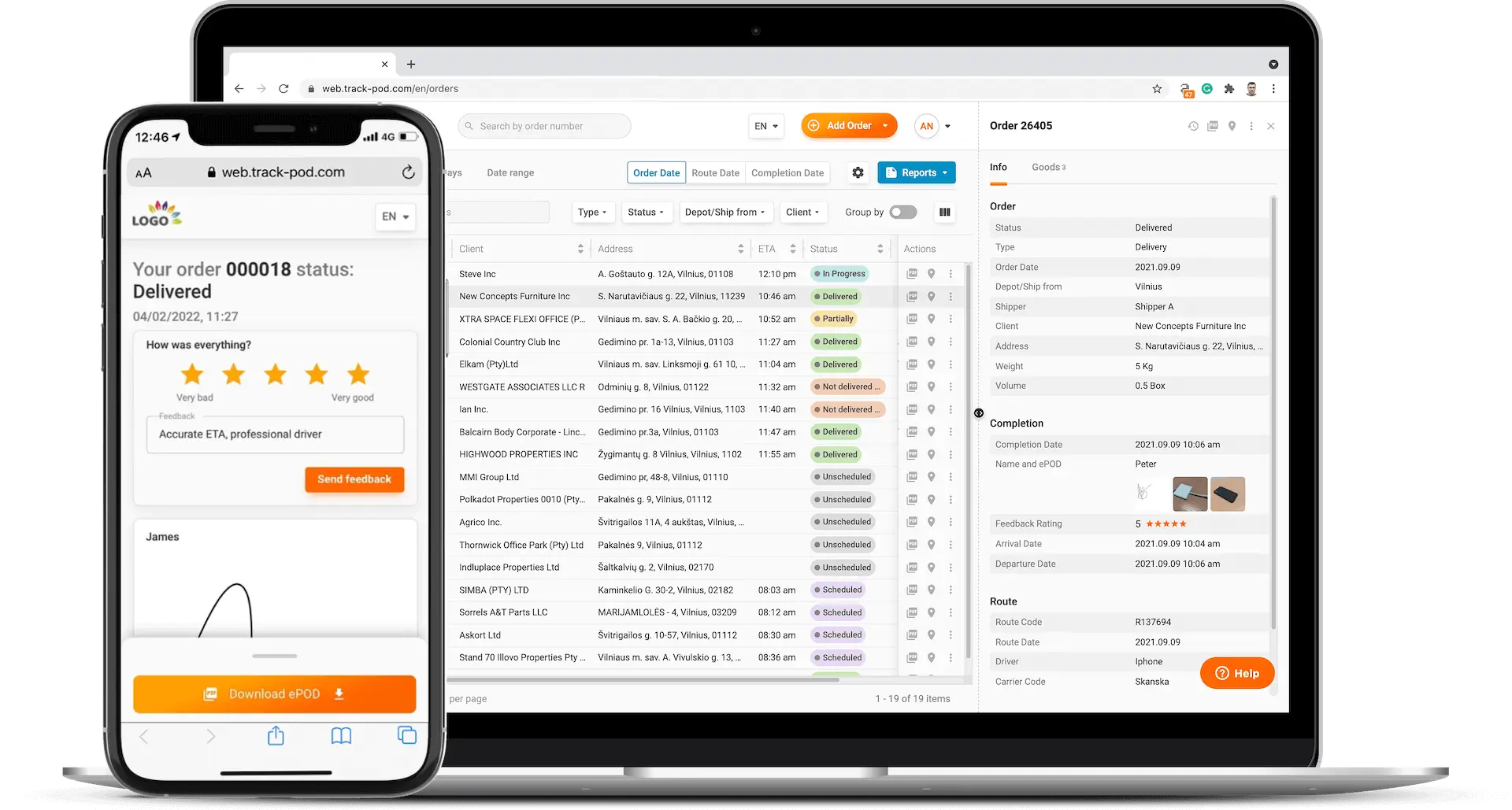
Overview: Track-POD is delivery management software that optimizes routes, tracks deliveries, and enhances customer experience through real-time updates.
Pros:
- Route Optimization: Provides efficient route planning, which reduces fuel costs and delivery times.
- Proof of Delivery: Offers features like digital signatures and photo proof, enhancing accountability and customer trust.
- Mobile App Access: Allows drivers to access delivery details and updates through a mobile app, improving communication.
Cons:
- Learning Curve: New users may take time to fully understand all features and functionalities.
- Support Limitations: Customer support may not be as responsive during peak times, leading to potential delays in issue resolution.
Onfleet Driver
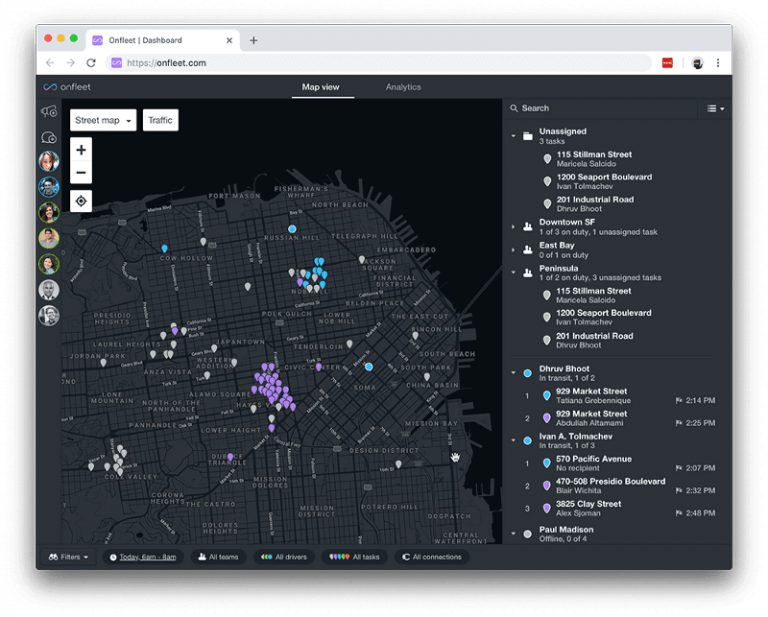
Onfleet Driver is part of the Onfleet logistics platform, focusing on optimizing the delivery experience for drivers and customers through easy-to-use tools and features.
Pros:
- Driver-Friendly Interface: The app is designed with drivers in mind, making it easy for them to navigate and manage their deliveries.
- Customer Notifications: Automatic SMS and email notifications keep customers informed about their delivery status, improving transparency.
- Analytics and Reporting: Provides detailed insights and analytics on delivery performance, helping businesses improve their operations.
Cons:
- Geographic Limitations: May not be as effective in rural areas where mapping and routing data are less accurate.
- Feature Overlap: Some users may find overlapping features with other tools, potentially leading to confusion about which software to use for specific tasks.
Route4Me
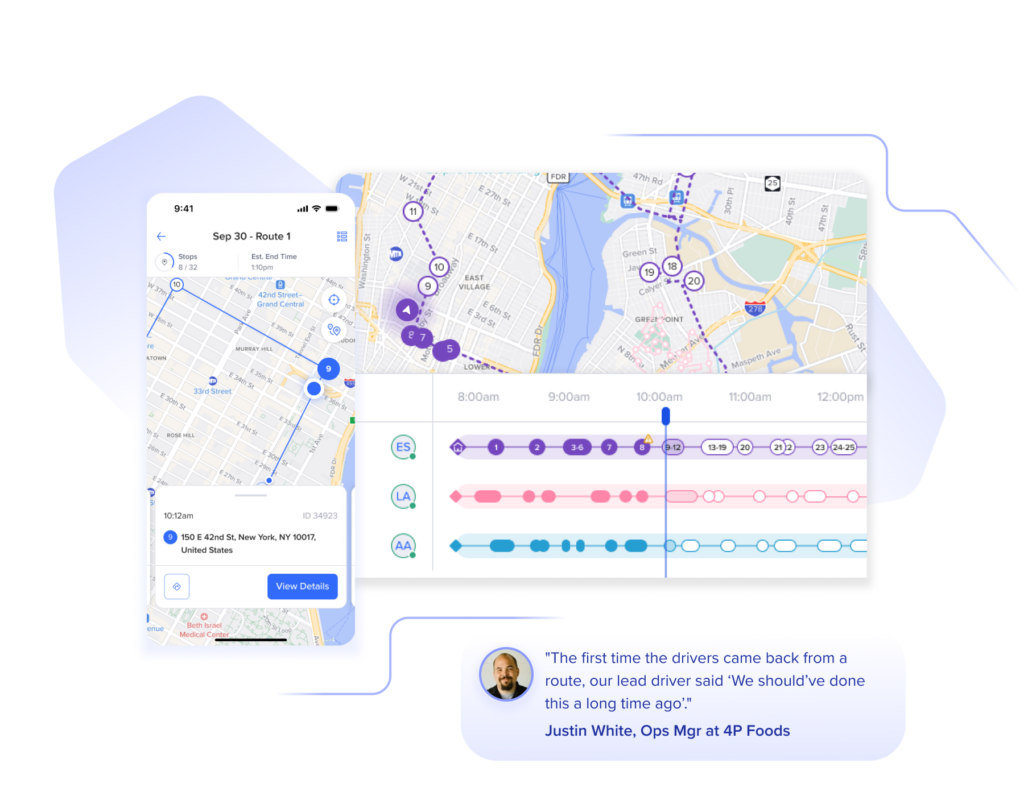
Route4Me is a route optimization and planning software that assists businesses in managing their delivery operations efficiently, particularly for fleet management.
Pros:
- Flexible Route Planning: Users can create and modify routes quickly, catering to changing delivery needs and schedules.
- Batch Route Planning: Allows users to plan multiple routes at once, saving time for businesses with high delivery volumes.
- API Availability: Offers an API for integration with other software systems, enhancing flexibility and adaptability.
Cons:
- User Interface Complexity: Some users find the interface less intuitive compared to competitors, which may affect usability.
- Subscription Cost: The monthly subscription fees can accumulate, especially for businesses that require advanced features.
Circuit
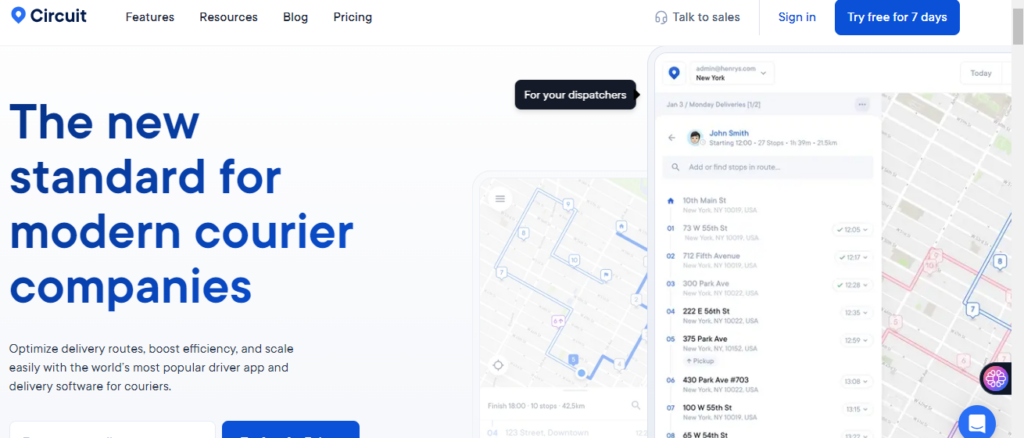
Circuit is route optimization software designed for small—to medium-sized businesses. It focuses on simplifying the delivery process and improving efficiency.
Pros:
- Simple and Intuitive: The user interface is easy to navigate, making it suitable for users with varying levels of tech proficiency.
- Real-time Traffic Updates: Integrates traffic data to adjust routes dynamically, helping to avoid delays and optimize delivery times.
- Cost-Effective: Offers competitive pricing plans, making it accessible for smaller businesses looking to enhance their delivery operations.
Cons:
- Limited Advanced Features: Lacks some advanced features that larger businesses might require for more complex delivery operations.
- Geographic Limitations: May not provide the best performance in areas with limited mapping data or where routing algorithms are less reliable.
Essential Features of Furniture Delivery Scheduling Software
Identifying the right furniture delivery scheduling software entails understanding the breadth of features that streamline operations. Recognizing these key functionalities allows businesses to significantly enhance efficiency in delivery management.
Real-time Tracking Capabilities
Software equipped with real-time tracking enables businesses and customers to monitor the precise location of deliveries. This feature ensures timely updates and allows for proactive management of delivery expectations.
Route Optimization Engines
Using refined algorithms, route optimization engines analyze numerous paths to ascertain the most efficient delivery route. This efficiency reduces fuel costs and maximizes the number of deliveries that can be achieved within a given timeframe.
Scalability and Customization Options
A business’s needs evolve over time, necessitating software that can adapt accordingly. Scalable solutions with customization options allow for tailored experiences that can grow and change with a business’s unique requirements.
Integration with Existing Management Systems
Linking software with existing inventory, CRM, and retail management systems creates a cohesive and interconnected operational platform. This integration fosters an environment where data flows seamlessly, reducing the likelihood of errors and enhancing the overall productivity of the delivery process.
- Real-time tracking capabilities show the exact status of each delivery, fostering transparency and reducing customer inquiries.
- Route optimization engines save time and resources, lowering operational costs and increasing delivery capacity.
- Scalability ensures the software can develop in line with your business, avoiding the need for frequent system changes.
- Integration maintains data accuracy and offers an all-encompassing view of the logistical and inventory landscape.
Reflect on your current delivery challenges and consider how the highlighted features align with your business’s strategic objectives. These key functionalities will define the right software choice.
Pro Tip: Choose furniture delivery scheduling software that offers real-time tracking, route optimization, and seamless integration to enhance efficiency, reduce costs, and scale with your business.
Advantages of Delivery Scheduling Software in Furniture Businesses
Furniture delivery scheduling software transforms logistical operations, transitioning from traditional methods to efficient digital solutions. The transition results in streamlined delivery processes, where software algorithms optimize routes and schedules to reduce wasted hours and resources.
Streamlining the Delivery Process
With delivery scheduling software, furniture businesses can consolidate orders, routes, and driver availability into one platform. The immediate benefit is a coherent workflow that easily adjusts to incoming orders, ensuring timely deliveries.
Enhancing the Accuracy of Delivery Windows
Customers expect precise delivery times. Delivery scheduling software calculates optimal routes and estimates arrival times with greater accuracy, which increases customer satisfaction and avoids the costs associated with late or failed deliveries.
Improving Overall Business Efficiency
Efficiency goes beyond the road. Delivery scheduling software provides managers with analytics on delivery performance, enabling data-driven decisions that boost the overall business operations, from inventory management to customer service times.
Transforming Customer Experiences with Furniture Delivery Software
Furniture delivery scheduling software reshapes how retailers offer personalized delivery schedules. Customers can select delivery times that fit seamlessly into their routines, transforming the anticipation of new furniture from inconvenience to excitement. Tailored scheduling empowers them with control over the delivery process.
Communication and tracking enhancements are central to software solutions, providing customers with real-time updates and peace of mind. The software enables them to monitor their delivery status, resulting in transparency that builds trust and fosters positive relationships between the retailer and the customer.
With sophisticated dispatch and routing algorithms, furniture delivery software facilitates faster service. Retailers can optimize delivery routes, ensuring furniture reaches its destination on time, if not earlier. Customers benefit from reduced wait times, and service reliability reinforces customer loyalty.
- Personalized delivery schedules cater to individual customer needs, promising convenience.
- Enhanced communication tools keep customers informed at every stage of the delivery process.
- Reliable delivery performance strengthens a retailer’s reputation for quality service.
Can software truly redefine the entire customer experience for furniture delivery? Reflect on the smooth integration of customer-focused features with the back-end logistics required in the furniture retail sector. As a result, customers experience exceptional service that encourages repeat business and positive word-of-mouth—a tangible benefit in a competitive market.
Enhance Your Retail Operations: Integrate Furniture Delivery Software Today
Integration of furniture delivery scheduling software with retail management systems transforms operations. Retailers experience streamlined workflows, offering a unified view of customer interactions and inventory levels. This integration supports a flawless furniture delivery process.
Seamless Data Transfer for Cohesive Retail Environment
Connecting delivery scheduling software with existing retail systems enables automatic data exchange. Sales orders, customer information, and inventory statuses move smoothly between platforms. Retailers experience efficiencies, reducing the potential for data entry errors and ensuring the availability of timely, accurate information for decision-making.
Unified Customer View Enhances Service Delivery
With synchronized systems, retailers gain a comprehensive view of their customers. Delivery scheduling software integrating retail management systems provides a single customer profile accessible across different business functions. Sales, support, and delivery teams access shared information, leading to consistent and personalized customer experiences.
Streamlining of Inventory and Delivery Workflows
Consolidation of delivery scheduling with inventory management eliminates silos. Retailers can monitor stock levels in real time, aligning this data with delivery schedules. Efficient inventory turnover is ensured, with the added benefit of optimizing delivery times, ultimately improving customer satisfaction.
- By interlinking data sources, retail staff can track products from warehouse to delivery without switching applications.
- The approach reduces overhead for managing separate systems and training staff on multiple tools.
- Incorporating software that integrates fully with existing systems offers agility, allowing retailers to adapt quickly to market changes or business growth.
The Role of Real-Time Tracking in Furniture Delivery
Real-time tracking is a stronghold in modern furniture delivery operations. Customers expect swift and reliable delivery services and complete visibility into the journey of their purchased items from warehouse to doorstep. The advent of GPS technology and sophisticated software solutions has made this at-the-minute tracking possible.
Building Customer Trust Through Transparency
Customers no longer remain in the dark about the whereabouts of their orders. With real-time tracking, they have access to live updates that pinpoint the exact location of their furniture during transit. This fosters a sense of participation in the delivery process and grows a trusting relationship between retailers and customers. Consequently, transparency reassures customers and significantly diminishes the volume of customer service calls asking for order status.
Empowering Businesses to Address Issues Proactively
Businesses benefit from real-time tracking by being equipped to handle logistical challenges efficiently. The instant access to tracking data allows companies to foresee delays, reroute drivers to avoid traffic congestion, and, thus, optimize delivery times. If an unexpected issue arises, such as a vehicle breakdown, companies can act swiftly to implement contingencies, minimizing negative impact and maintaining service quality.
The Technology Behind Real-Time Tracking
The backbone of real-time tracking is a complex interplay of GPS technology, Internet of Things (IoT) devices, and robust delivery scheduling software. GPS provides geolocation data, which transmits location information to the furniture delivery scheduling software when paired with mobile technology. Retailers can then process this data to give real-time updates to customers and make informed decisions about their fleet management.
- GPS units in delivery vehicles connect with global satellites to provide precise location details.
- IoT sensors can report additional information, such as temperature, which can be crucial for preserving the condition of certain furniture items during transit.
- The seamless integration of this technology into furniture delivery scheduling software ensures a rich data ecosystem for real-time tracking and advancing logistical analytics.
The once static and opaque delivery process has transformed into a dynamic, interactive experience through real-time tracking. This offers deep insights and operational control for furniture businesses and delivers superior customer service.
Strategies for Effective Delivery Route Optimization
Efficient route planning leads to substantial fuel and time savings, contributing to environmental sustainability and lower operational costs. With delivery route optimization, furniture businesses can ensure that trucks traveling from warehouses to customers’ homes take the most effective paths, reducing unnecessary mileage and CO2 emissions.
Maximizing Delivery Efficiency Through Route Planning
Proper route planning ensures furniture deliveries occur within the shortest time frames and at the lowest cost. Advanced scheduling software considers numerous variables, such as traffic patterns, weather conditions, and driver availability, creating an adaptive scheduling environment that improves with each successful delivery.
Reaping Environmental and Economic Rewards
Optimized routes not only minimize fuel consumption but also contribute to a decrease in overall vehicle maintenance. Reducing driven miles equals fewer oil changes, tire replacements, and general wear and tear, which cumulatively enhance a company’s profit margin and environmental footprint.
Mapping the Road to Success: Tips for Optimized Delivery Routes
- Analyze historical data to identify patterns and recurring challenges in delivery routes.
- Leverage dynamic routing capabilities that adjust to real-time external factors like road closures or delays.
- Group deliveries geographically to minimize travel distance between stops.
- Utilize predictive analytics to forecast the best delivery windows, sidestepping traffic peak times.
- Employ continuous feedback loops for drivers to report on route success and areas for improvement.
By adhering to these strategies, furniture delivery companies can ensure that their route optimization efforts yield consistent and measurable customer satisfaction and operational efficiency improvements. Software solutions specialized in delivery scheduling are pivotal in unlocking these benefits through sophisticated algorithms and user-friendly interfaces.
Pro Tip: Optimize delivery routes by analyzing historical data and leveraging real-time traffic adjustments to minimize travel time and costs.
The Impact of Delivery Scheduling Software on Logistics Efficiency
The implementation of delivery scheduling software significantly streamlines logistics in the furniture industry. Observations from numerous case studies have shown that incorporating such technology leads to measurable improvements in operational workflows. From the precise coordination of delivery routes to enhanced inventory management, the ripple effect on logistics cannot be overstated.
Statistics on Time and Resource Savings
Route optimization is a vital feature that yields significant time and resource savings. Statistics show that by implementing this tool, deliveries can be reduced by 20-30%, leading to notable decreases in fuel consumption and operational costs. It effectively analyzes traffic patterns and delivery time windows, ensuring that the most efficient routes are selected for each delivery. As a result, businesses can save valuable time, enabling them to focus on other critical tasks while reducing their overall carbon footprint. These improvements enhance operational efficiency, resulting in higher customer satisfaction and greater resource management.
How Technology Is Redefining Logistics in Furniture Delivery
Technology is a driving force for innovation in the furniture delivery landscape. Integrating advanced scheduling algorithms and real-time data analytics has redefined logistics flow, enabling retailers to adapt to the fast-paced market. By leveraging technology to predict traffic patterns, weather conditions, and customer preferences, companies achieve unparalleled logistical precision.
- Delivery routes are crafted optimally, considering real-time road conditions and order priorities.
- Customer satisfaction surges as a result of precise delivery time forecasts.
- Increased transparency throughout the delivery chain ensures that stakeholders are well-informed of each step in the process.
Utilizing these advanced tools, furniture businesses can expect to meet and often exceed customer expectations, fostering loyalty and repeat business. Moreover, reducing resource expenditure contributes to a healthier bottom line, thus reaffirming the decision to invest in delivery scheduling software.
Unlock Financial Efficiency with Furniture Delivery Scheduling Software
Implementing furniture delivery scheduling software can yield considerable cost savings alongside the potential for an impressive return on investment (ROI). By automating scheduling, dispatch, and routing processes, furniture businesses can reduce labor costs and fuel expenditures while also maximizing vehicle capacity and streamlining deliveries.
Investment vs. Returns: A Critical Assessment
Assessing the initial investment against the projected returns illustrates the financial prudence of adopting delivery scheduling solutions. Retailers often notice reduced overheads as the precision of delivery scheduling minimizes idle time and unnecessary overstaffing. These software systems usually pay for themselves within months, predicated on variables such as delivery volume, fleet size, and operational complexity.
Tracking and Measuring ROI Post-Implementation
To fully understand the financial impacts, retailers must adopt robust metrics to track and measure ROI following the deployment of scheduling solutions. Key performance indicators may include a decrease in miles driven per delivery, increased deliveries completed per day, and reduced fuel costs or overtime wages. Data analytics provided by the software can often assist in this monitoring, offering comprehensive reports on performance improvements and cost reductions.
- Fuel consumption patterns before and after implementation provide direct insight into efficiency gains.
- Customer satisfaction scores and repeat business rates can indirectly indicate successful optimization and increased profitability.
- Analysis of time saved through route optimization and delivery density can quantify increased workforce productivity.
Long-term Financial Benefits for Furniture Retailers
Long-term financial benefits manifest as an extension of the immediate cost savings. Retailers experience a decrease in capital tied up in inventory thanks to faster turnover and improved delivery processes, freeing up resources for investment in growth or innovation. Enhanced data collection from the delivery process can also aid future budgeting and operational planning, fostering ongoing financial health.
Successful furniture retailers do not just anticipate immediate savings but also position their businesses for sustainable growth, competitive advantage, and customer retention through the strategic application of delivery scheduling software.
Choosing the Right Furniture Delivery Scheduling Software for Your Business
When selecting a furniture delivery scheduling software for your enterprise, the decision must align with your unique business specifications. Assessing both enterprise scale and specific needs frames the decision-making process. A comprehensive approach to evaluation will ensure an optimal match between the software capabilities and operational demands.
Assessing Your Business Needs and Size
The selection is based on an intimate understanding of business workflows, customer base, and delivery volume. Different software caters to varying levels of complexity and scale. A small local store operates with a smaller margin for error than a multi-branch retailer; hence, the requirements for software assistance might differ significantly.
Comparing Leading Software Options in the Market
With a plethora of software options available, a systematic comparison is paramount. Leading solutions often offer a demo or trial period, which allows for firsthand evaluation of the user interface, feature set, and adaptability to your business process. This experiential insight proves invaluable.
- Feature Sets: Balance is key; excess features can overwhelm while too few can handicap. Evaluate core functionalities such as order management, routing algorithms, and customer communication portals.
- User Experience: A seamless user interface enhances staff adoption and minimizes training challenges. User experience often directly correlates with day-to-day operational efficiency.
- Support and Training: The software should come with accessible and comprehensive support. Downtime and troubleshooting must be handled promptly to avoid disruptions.
- Integration Capabilities: Software that integrates with existing retail management systems streamlines operations, synchronizing data between sales and delivery.
The Top Considerations Before Making a Decision
The choice of software will have long-term repercussions on the business. Cost is a critical aspect but must be weighed alongside the potential for scalability and future growth. Security features protect sensitive customer data and should not be overlooked. Any prospective software must also comply with pertinent regulations to sidestep legal pitfalls.
Opting for a software solution with robust analytics capabilities allows businesses to track performance, identify areas for improvement, and make data-driven decisions. The ability to provide customers with accurate and timely delivery updates solidifies trust and loyalty.
Reflecting on your business model, the selection process becomes a strategic investment. The right furniture delivery scheduling software does more than track and manage; it becomes an intrinsic component of your business’s capacity to innovate, satisfy, and expand.
Pro Tip: When choosing furniture delivery scheduling software, prioritize solutions that align with your business needs, offer a user-friendly interface, integrate with existing systems, and provide robust analytics to enhance operational efficiency and customer satisfaction.
Exploring the Horizon: Furniture Delivery and Logistics Evolved
The furniture delivery and logistics landscape continues to transform with the advent of new technologies. Upcoming innovations will redefine the speed, efficiency, and convenience of how furniture reaches consumers. Artificial intelligence (AI) and machine learning stand at the forefront of these advancements, poised to revolutionize delivery logistics by enabling predictive analytics, dynamic routing, and personalized customer interactions.
Emerging Trends and Innovations in Delivery Software
The integration of advanced algorithms within delivery software permits heightened levels of optimization. These trends include adopting autonomous delivery vehicles and drones, which reduce delivery times and address the last-mile challenge. Additionally, the application of Internet of Things (IoT) devices ensures real-time data flows, leading to enhanced transparency in the delivery pipeline. Consumers and suppliers benefit from incorporating blockchain technology, which ensures unparalleled security and trust in transactional records.
Predictions on How Technology Will Shape Future Customer Experiences
Future customer experiences are likely to be defined by highly customized service standards. Expectations for same-day deliveries may transition from a luxury to a norm. Furniture buyers will likely witness a surge in interactive scheduling platforms where they control the timing and specifics of their delivery. The ability to modify delivery details on the fly through advanced customer portals will cater to the demand for greater control and convenience.
The Potential of AI and Machine Learning in Delivery Logistics
- AI propels intelligent route planning that adapts to traffic patterns, weather conditions, and emerging obstacles, reducing the risk of delays.
- Machine learning synthesizes historical data to forecast demand spikes, guiding inventory distribution and preventing stock shortages.
- Customer service is enhanced as AI-driven chatbots instantly respond to delivery inquiries, improving the overall experience.
- AI-powered automated systems will increasingly handle routine logistics processes, freeing human resources for complex problem-solving tasks.
Furniture delivery and logistics technology is relentlessly marching towards greater sophistication. As these forthcoming tools and frameworks take hold, the efficiency, accuracy, and personalization of the delivery experience will ascend to unprecedented levels, setting new benchmarks within the furniture industry.
Maximize Team Competency with Strategic Training on Furniture Delivery Scheduling Software
Furniture businesses witness a transformative impact when equipping their teams with comprehensive know-how of their new delivery scheduling tools. Mastery of these systems leads to optimized operations, substantial cost savings, and enhanced customer satisfaction. Thus, adapting staff to leverage the full spectrum of features in newly implemented software is a driving force behind realizing these benefits.
Crafting a Tailored Training Plan
Assembling a bespoke training strategy presents a foundational step toward empowering employees. This plan outlines clear objectives, practical sessions, and timelines to facilitate a smooth transition. Employees engage in hands-on experiences with the software, improving proficiency through mock scenarios that reflect real-world challenges they will face during furniture delivery processes.
Ongoing Support and Educational Tools
Maintaining a supportive environment plays a critical role in fostering continuous learning. Providing easily accessible resources, like help guides, FAQs, and a dedicated helpdesk, ensures that teams feel confident using software to its full potential. Webinars and workshops can be instituted to address any evolving needs as staff become more adept at navigating the software’s nuances.
- Deploy interactive training modules to captivate attention and enhance retention.
- Ensure that troubleshooting procedures are covered to equip staff with problem-solving skills.
- Use data and analytics from the software to illustrate tangible effects on performance and service quality.
As proficiency within the team grows, the seemingly complex intricacies of delivery scheduling software will become second nature, enabling staff to extract actionable insights, anticipate delivery challenges, and deliver superior service to customers. This investment in training not only upskill the team but also fortifies the business’s ability to adapt to market changes and future technology integrations.
Addressing Common Challenges in Furniture Delivery Management
Even with state-of-the-art furniture delivery scheduling software, businesses face hurdles that require strategic solutions. Last-mile delivery, in particular, represents a complex stage where efficiency meets customer expectations. Navigating urban streets, scheduling within narrow time windows, and managing customer availability are tangible trials. However, strategic planning, enabled by software that provides optimized routes and real-time tracking, can significantly alleviate these obstacles.
Unexpected delays and customer issues also merit a systematic approach. Robust software equips businesses with the agility to reroute deliveries on the fly and communicate with customers proactively to manage expectations. The capability to update ETAs based on traffic conditions or on-the-ground challenges transforms potential customer dissatisfaction into an opportunity to demonstrate reliability and commitment.
Handling Last-Mile Delivery Hurdles
- Maximizing route efficiency by analyzing historical data and predicting traffic patterns ensures drivers complete more deliveries in less time.
- Automating customer communication provides timely updates about delivery status, reducing the need for manual outreach and minimizing the risk of missed deliveries.
- Electronic proof of delivery captures customers’ signatures digitally, streamlining the last stage of the delivery process for drivers and customers alike.
Solutions for Unexpected Delays and Customer Issues
- Real-time tracking and dynamic rerouting based on current traffic and weather conditions help mitigate the effects of unforeseen delays.
- Customer service platforms integrated with delivery software enable support teams to resolve issues swiftly, with all delivery information at their fingertips.
- Offering self-service options allows customers to reschedule deliveries, enhancing flexibility and satisfaction.
Strategies to Improve Operational Resilience
- Centralized dashboards grant visibility into fleet operations, enabling rapid response to disruptions and balanced workload distribution.
- Collecting and analyzing delivery data informs continuous improvement initiatives that lead to stronger operational practices over time.
- Cultivating a culture of feedback among delivery personnel encourages the reporting of on-ground challenges, promoting proactive problem-solving.
Deploying technology solutions effectively transforms challenges into opportunities. Enhanced visibility, communication, and data-driven decision-making drive operational resilience in furniture delivery management.
Key Takeaways
- Streamlined Operations: Furniture delivery scheduling software automates and optimizes the entire delivery process, reducing manual errors and saving time for logistics teams.
- Improved Customer Experience: Features like real-time tracking and notifications allow customers to stay informed about their delivery status, enhancing satisfaction and trust.
- Efficient Route Planning: Advanced algorithms help plan the most efficient delivery routes, minimizing fuel costs and delivery times, leading to better resource management.
- Data-Driven Insights: The software provides valuable analytics and reporting tools that enable businesses to monitor performance, identify bottlenecks, and make informed decisions for continuous improvement.
- Scalability and Flexibility: As furniture businesses grow, scheduling software can easily adapt to increasing demands, allowing for smooth operations scaling and the ability to manage multiple deliveries simultaneously.
Wrapping It Up!
Customers expect prompt and accurate delivery schedules when they purchase furniture. Delivery scheduling software seamlessly meets these expectations by streamlining operations. Retailers that deploy such solutions observe noticeable enhancements in delivery speed, efficiency, and customer satisfaction. Furniture delivery scheduling software not only upgrades how deliveries are handled but is now a pivotal component of a competitive business model in the furniture industry.
Embracing advanced delivery logistics technology offers a forward-looking approach to handling the complexities of furniture distribution. Furniture retailers gain the ability to adapt to evolving market demands and customer preferences. In an increasingly digital world, the ability to incorporate technology into all facets of operations is no longer an advantage but a necessity for staying relevant and profitable.
Retailers must assess their delivery management processes and consider the potential returns of investing in delivery scheduling software. Software solutions vary; choosing the right one will align with immediate needs and future growth. Implementing the right software will enhance operational capacity, improve customer retention, and ensure an enduring market presence.
Strong delivery logistics shape the backbone of successful furniture retail businesses. Taking steps towards advanced scheduling solutions will significantly contribute to a retailer’s success in meeting modern commerce challenges.
Elevate your furniture delivery operations with NetworkON’s advanced delivery scheduling software! Streamline your logistics, enhance customer satisfaction, and stay ahead of market demands.
Contact us today to learn how our furniture delivery scheduling software can transform your business and ensure lasting success in the furniture retail industry!
Frequently Asked Questions
What features should I look for in furniture delivery scheduling software?
Look for features such as real-time tracking, route optimization, customer notifications, analytics and reporting, integration with existing systems, and mobile accessibility for delivery personnel. These features can enhance efficiency and improve the customer experience.
How can furniture delivery scheduling software improve my business operations?
The software automates scheduling, reduces manual errors, optimizes routes for faster deliveries, and provides real-time updates to customers. This leads to improved operational efficiency, lower costs, and higher customer satisfaction.
Is furniture delivery scheduling software easy to integrate with my existing systems?
Most modern delivery scheduling software is designed to integrate seamlessly with various platforms, such as inventory management, CRM systems, and e-commerce solutions. To ensure a smooth transition, it’s important to choose software that offers robust integration options.
Can furniture delivery scheduling software handle peak seasons or high order volumes
Yes, many scheduling software solutions are scalable and can accommodate fluctuations in order volume, especially during peak seasons. They can efficiently manage multiple deliveries and resources, ensuring your operations remain smooth and responsive to demand changes.
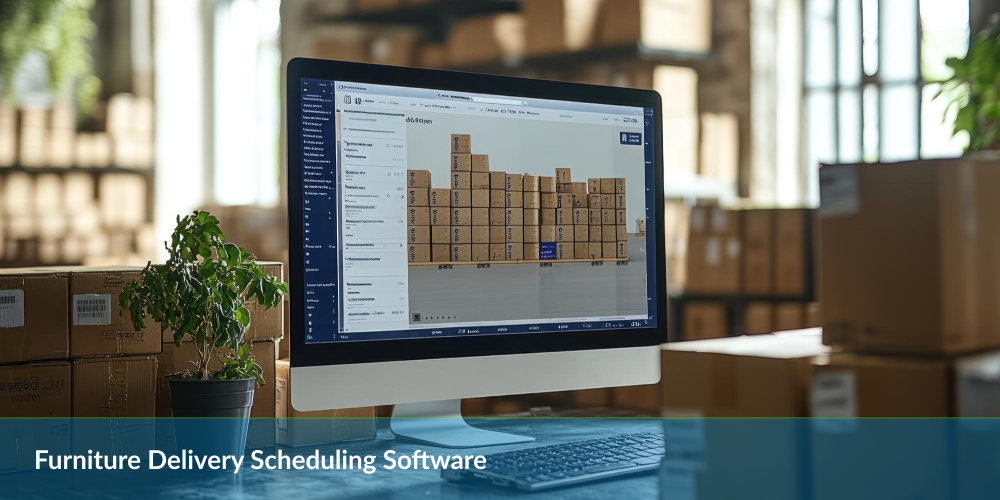



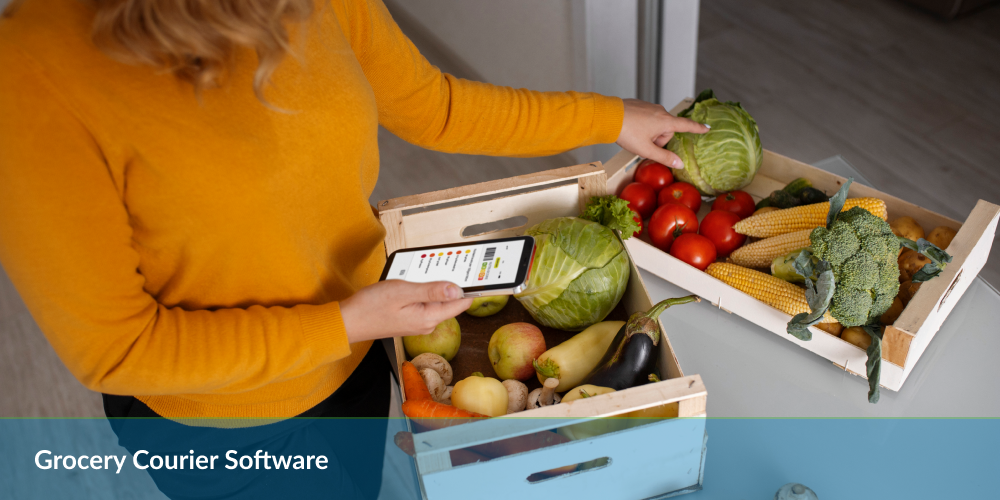
0 Conversations